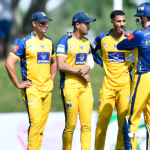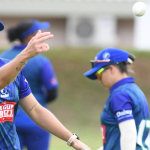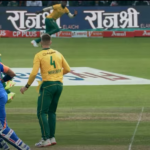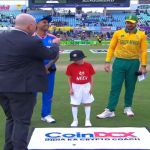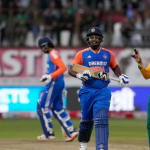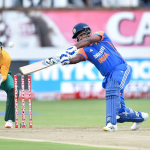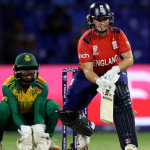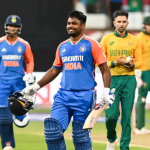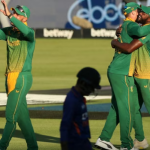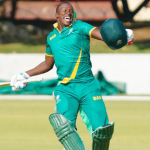Oshada Hits Century in Kimberley. In the competitive world of international cricket, performances in unofficial Test matches often provide a glimpse into the form and future potential of players. One such performance came from Oshada Fernando, who showcased his batting prowess with a stunning century during the first Test match between South Africa A and Sri Lanka A in Kimberley. His century not only highlighted his skill but also re-established his standing as a key figure in Sri Lanka’s batting lineup. The match was not only a contest between two teams but also a platform where individual brilliance, team strategies, and tactical plays came into the spotlight.
In this article, we will explore the intricate details of Oshada Fernando’s century, analyzing the biometric factors that may have contributed to his performance, reviewing the match context, and discussing its broader implications. We will also touch on the other significant contributions made during the match, especially focusing on the interplay of South Africa A and Sri Lanka A squads.
The Match Context: Setting the Stage in Kimberley
The first unofficial Test between South Africa A and Sri Lanka A began with South Africa choosing to bat in the favorable conditions of Kimberley Oval. With the home team finishing the first day at 294 for four, the stage was set for a tough contest. The impressive performance by the likes of Matthew Breetzke (129 off 213 balls) and others gave South Africa a firm upper hand early in the match.
South Africa’s innings concluded at 372, after a collapse in the lower order which saw them adding just 78 more runs on day two. Sri Lanka A’s response, however, came strong with Oshada Fernando leading the charge. By the end of day two, Sri Lanka A had posted 232 for four, largely on the back of Oshada Fernando’s blistering century. This response brought the visitors within striking distance of South Africa’s total, making the contest exciting and evenly poised for the upcoming days.
Oshada Fernando’s Century: A Masterclass in Batting
Oshada Fernando’s century was a textbook example of controlled aggression. His score of 122 from 146 balls, laced with 21 boundaries, was more than just a statistical achievement—it was a statement of intent. Fernando’s ability to control the tempo of the game while keeping his strike rate high was a key aspect of his knock.
Key Biometric Indicators Behind Fernando’s Knock
- Batting Stance and Grip: Oshada’s batting stance and grip allow for powerful shots while maintaining control. His upright posture ensures he can judge the length of the ball early, which explains his ability to play both front-foot and back-foot shots effectively. This is crucial for facing fast bowlers in South African conditions.
- Reaction Time and Footwork: Fernando’s quick reaction time and nimble footwork were instrumental in countering the South African bowlers, especially on a pitch that provided some assistance to the seamers. His ability to read the movement off the pitch and adjust his footwork accordingly minimized the risk of playing loose shots outside the off-stump.
- Concentration Levels: As his innings progressed, Fernando’s concentration and focus allowed him to play long spells without losing his wicket. High concentration levels are often seen as an indicator of a player’s mental strength, and Oshada demonstrated this attribute by staying composed throughout his knock.
- Energy Conservation: Batting in humid and tiring conditions can take a toll on players. Oshada’s fitness levels allowed him to conserve energy between the wickets while maintaining sharpness in his shot-making.
How Fernando’s Century Shaped the Match
Fernando’s century came at a crucial juncture for Sri Lanka A. With his team under pressure after losing two early wickets, his partnership of 153 runs with captain Pasindu Sooriyabandara helped stabilize the innings and kept Sri Lanka A competitive. This third-wicket stand brought Sri Lanka A from a vulnerable position to one of relative strength by the end of day two, ensuring they remained within touching distance of South Africa’s total.
South Africa’s Response
While Oshada Fernando was the star of day two, South Africa A had their own highlights. Matthew Breetzke continued his overnight score of 112 to finish at 129, ensuring that his team reached a strong total of 372. However, the home side might have felt slightly disappointed, considering they were 294 for four at the close of day one.
Eshan Malinga was the pick of Sri Lanka A’s bowlers, with figures of 4/65. His ability to extract movement from the pitch, combined with his accurate line and length, troubled the South African batsmen, particularly in the lower order. The dismissals of key lower-order players put the brakes on South Africa’s scoring, giving Sri Lanka A a fighting chance as they came out to bat.
Bowling Contributions from Sri Lanka A
In addition to Malinga’s exploits, other bowlers like Isitha Wijesundara, Chamika Gunasekara, and Nishan Peiris also contributed by sharing the remaining six wickets. The combined effort of the Sri Lankan bowlers kept the South African batsmen in check and prevented a complete domination from the hosts.
Strategic Insights and Tactical Plays
This match was a blend of individual brilliance and team tactics. For Sri Lanka A, the decision to send Oshada Fernando at number three was pivotal. His placement in the batting order ensured that Sri Lanka had a reliable figure to anchor the innings, especially after the early dismissals of Lahiru Udara and Nuwanidu Fernando.
South Africa A’s bowling strategy, on the other hand, was focused on early breakthroughs. The successful dismissals of Sri Lanka’s openers by Migael Pretorius and Prenelan Subrayen gave them a brief upper hand, but the partnership between Oshada and Sooriyabandara took the game away from them.
Player Profiles: Oshada Fernando and Matthew Breetzke
Oshada Fernando
A consistent performer for Sri Lanka A, Oshada’s technique and temperament make him a key player for the future. His century in Kimberley has only strengthened his claim for a permanent spot in the senior Sri Lankan side. His performance in this match was a masterclass in concentration and aggression, as he combined technical precision with an attacking mindset.
Matthew Breetzke
For South Africa A, Breetzke’s century laid the foundation for their first innings score. His calmness at the crease and ability to play long innings underlined his potential as a future star for the South African team. His batting technique and mental toughness, as evidenced in this match, are signs of a player with the ability to adapt to different conditions.
The Second Test in Benoni
With the first Test evenly poised, attention now shifts to the second unofficial Test between South Africa A and Sri Lanka A, which is set to be held at Willowmoore Park, Benoni. Both teams will be looking to build on their performances from the first match, and individual players will be eager to make a lasting impression.
Conclusion
A-Team matches such as this one are often seen as stepping stones for players aiming to break into the national setup. For Oshada Fernando, his century in Kimberley was a statement of intent, while Matthew Breetzke’s innings further established his credentials as a player to watch for South Africa.

